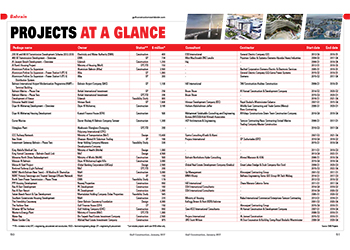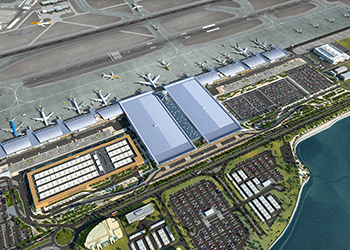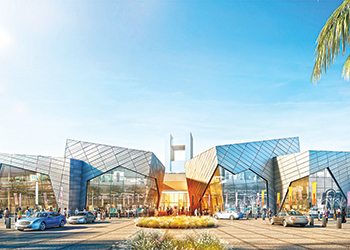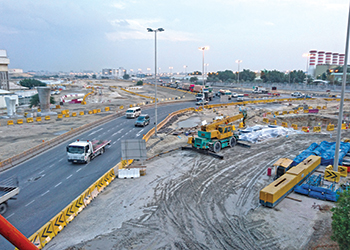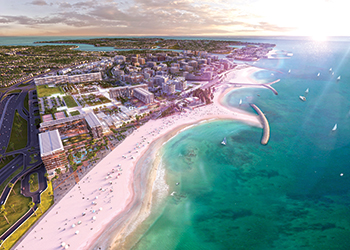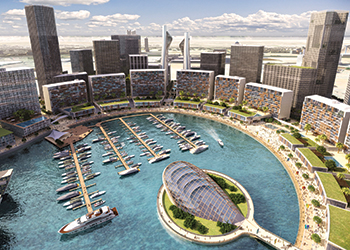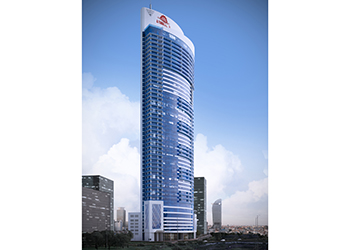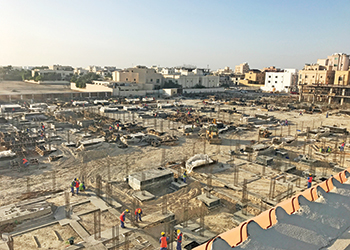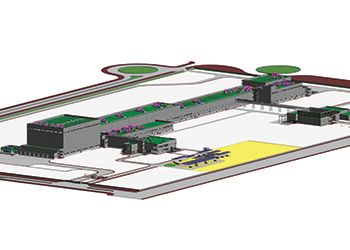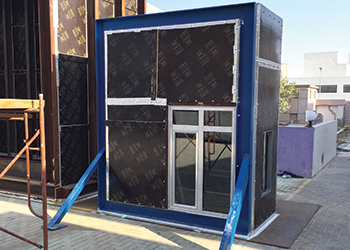
 Mega developments ... the $80-million Layyan, part of the $1.3-billion Durrat Marina.
Mega developments ... the $80-million Layyan, part of the $1.3-billion Durrat Marina.
A huge demand for housing, mega infrastructural and real estate projects and a robust diversification drive is helping Bahrain post strong growth in its construction sector.
2017 promises to be one of the brightest years for Bahrain’s construction industry in recent times, given a healthy projects pipeline which includes big-ticket industrial ventures, mega infrastructural development, key social housing initiatives and an upbeat real estate sector.
The island nation flagged off one of its largest infrastructural projects early last year with the award of the main contract for a $1.1-billion expansion of its international airport.
The expansion, which is the largest in the history of civil aviation in Bahrain, is among mega developments worth more than $32 billion, to be implemented in the kingdom in the coming years to boost economic development, according to the kingdom’s Prime Minister, HRH Prince Khalifa bin Salman Al Khalifa.
Impressive progress has been made in Bahrain’s drive to address its housing shortage with the private sector having joined hands to meet surging demand. Work is under way or set to be launched on five new towns and other housing schemes which will address the country’s shortfall with a whopping 40,000 units.
While low oil prices have certainly cast a gloom over the entire GCC region including Bahrain, gauging by the number of projects on the anvil, there should be ample opportunities in the construction sector in the medium term.
Driving the sector’s growth over the past year has been the Gulf Development Fund, agreed upon in 2013 in the wake of the Arab Spring.
According to the latest economic quarterly update from the Bahrain Economic Development Board, the kingdom’s total projects pipeline – including long-term builds like the proposed $3-billion King Hamad Causeway, the second Bahrain-Saudi link, set to be completed around 2025 – amounts to $72.7 billion, up 4.7 per cent year-on-year. This pipeline anticipates robust industrial growth with the $5-billion Bahrain Petroleum Company (Bapco) upgrade and expansion of the Sitra refinery – a contract for which is expected in the current quarter; the $3-billion Aluminium Bahrain (Alba) Line Six smelting project; and the $655-million offshore liquefied natural gas (LNG) terminal being commissioned by the National Oil and Gas Authority (Noga).
Another key project is a $1-billion medical city, tenders for which have already been invited (see Regional News).
BMI (Business Monitor International) Research expects Bahrain’s construction industry to grow at a rate of 6.6 per cent in 2017 and 6.7 per cent in 2018, if the projects that are under construction or in the planning stage proceed on schedule. The research organisation forecasts an average growth rate of 5.8 per cent year-on-year (y-o-y) over the 2017-2026 period.
In its latest infrastructure report on Bahrain, BMI indicates that several large projects are ongoing and are set to boost growth, notably to 2019, particularly in the residential construction sector, where the government’s continued focus on affordable housing will see the sector assuming a greater role in driving growth over the coming years. The report does however, point out, that Bahrain is heavily reliant on its oil and gas sector – deriving 90 per cent of its revenue from it, and the prevailing oil prices continue to weigh on public spending and business confidence.
Airport
Following the award of the main contract early last year, a joint venture of the UAE’s Arabtec Holding and Turkey’s TAV Construction (TAV) is working on a new terminal which forms part of Bahrain International Airport’s (BIA) modernisation and expansion project. The $1.1-billion airport modernisation programme (AMP) involves the construction of the new 207,000-sq-m terminal which will double the annual capacity of the airport to 14 million passengers (see Page 52).
The project, which to be completed by the third quarter of 2019, is funded by the Gulf Development Fund.
 |
The fourth Muharraq bridge ... will link Bahrain Bay with Busaiteen. |
Housing
Bahrain’s Ministry of Housing is spearheading the construction of five mega residential projects across the kingdom, namely the Northern Town, East Hidd Town, East Sitra, the Southern Town and Al Ramli. A total of 40,000 units will be built in these new towns along with an additional 25,000 units to be completed by 2018 under the government action programme (GAP).
Bahrain is poised to launch work this year on the 3,520-unit Al Ramli Housing Project, which is being funded by the Gulf Development Fund. Tenders have been invited for the first phase of the project which entails the construction of 1,246 homes.
Meanwhile, following completion of reclamation, work is set to start on the East Sitra Housing Project which will see the construction of 5,000 units.
Among the most advanced of the new townships is the Al Madina Al Shamaliya (Northern Town), a major islands project located on reclaimed land off the northern coast of Bahrain. Work is set to start on the primary infrastructure and bridges on Islands 13 and 14 (East), which are expected to deliver 2,000 housing units under an affordable housing scheme by the Ministry of Housing.
At East Hidd, the first 487 units of the two-phase housing project were completed early last year, while work on 398 further units is at an advanced stage. A total of 4,548 units are to be built as part of the 227-hectares development.
Private sector firms such as Naseej and Diyar Al Muharraq are supporting government efforts and banks and finance houses joining in to provide attractive finance options to purchasers such as Mazaya, a social housing finance scheme between the Housing Ministry and KFH-Bahrain to offer loans subsidised by the government.
More than 6,200 housing units were handed over in 2016 by the Ministry of Housing, which is now looking to acquire necessary land in several areas of the kingdom for the construction of 25,000 new housing units for its citizens.
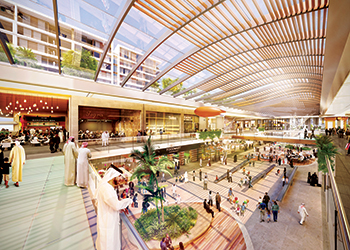 |
Marassi Galleria, part of the $3-billion Marassi Al Bahrain. |
Real Estate
Recent property exhibitions such as the Gulf Property Show and Bipex have amply showcased the wealth of imaginative real estate projects available for investors in the country. Among the striking developments on offer are Bahrain Bay, Marassi Al Bahrain, Layyan, Al Sidra, Dilmunia and its third-party developments such as CanalViews and Water Garden City.
The $2.5-billion Bahrain Bay development has recorded impressive growth with more than 86 per cent of plots sold, the infrastructure complete and projects of a number of third-party developers nearing completion.
Diyar Al Muharraq is unrolling the next phase of development at its landmark development off the northern coast of Muharraq in partnership with the UAE-based Eagle Hills with the construction of $3-billion Marassi Al Bahrain and in particular the Marassi Residences and Marassi Galleria (see Page 58).
At the development, third-party developer Bin Faqeeh has launched Alsidra, a 465-villas luxury gated community valued at BD85 million ($223.67 million), which is scheduled to be completed by the first quarter of 2019 (see Page 54-55).
At Dilmunia health island, Bahraini developer Naseej is developing the multimillion-dollar CanalView project. Covering an area of 13,068 sq m, the mixed-use development features a number of multi-storey buildings, with 250 residential apartments overlooking a canal.
Among other developments, Bahrain Real Estate Investment (Edamah) has five major projects on the anvil, namely Sa’ada, a BD45-million ($117.4 million) waterfront development in Muharraq; a BD350-million ($913 million) North Hawar eco-friendly development; The Terminal, a multi-storey car park in Adliya; Versaille Plaza, a French-themed cultural hub; and Sharwa, a retail strip in Isa Town.
The largest is the plan to transform Hawar Islands into a signature eco-friendly tourism destination. Construction work is due to begin this year, with the resort scheduled to open in 2019.
According to leading international real estate consultant Cluttons, the recent decision by the government to allow foreigner investors 100 per cent ownership in various sectors of the market is likely to have a positive long-term impact on the kingdom’s property markets. The new law will allow 100 per cent ownership in residency, real estate, administrative services, health and social work, information and communications, manufacturing and other technical activities.
Another initiative being taken to boost investor confidence is the restarting of stalled projects. Among such moves, bids have been invited for the sale of the Marina West development, following successful sale of the Juffair Views project (see Regional News).
Apart from Juffair Views and Marina West, Bahrain’s Ministry of Justice has the mandate to restart work on the Amwaj Gateway and Views and Sunset Hills.
Among other stalled projects, work on Villamar@The Harbour residential development at Bahrain Financial Harbour resumed after a three-year hiatus (see Regional News).
In the retail sector, mega developments include The Avenues mall, work on which is progressing well. Construction is also under way on the third and largest Oasis Mall in Bahrain, located at Juffair (see separate article).
Another shopping complex, the $30-million Atrium Mall, is expected to be completed by the end of 2017.
Power & Water
A BD280-million ($738 million) power grid development project, which is among the largest in this sector, was launched last June. The project, aimed at reducing short circuits and ensuring efficient transfer of electricity across the kingdom, will be completed by 2017-end. The scope of work includes building three 400 kV electricity transmission lines in Hidd, Um Al Hassam and Riffa and linking them.
Meanwhile, SNC-Lavalin has been signed up for the construction of 11 kV substations in the kingdom and designing of cabling network circuits. The project is scheduled for completion in December.
Roads
Among the largest projects in the roads sector to be launched is the second phase of the North Manama Causeway (fourth Muharraq Bridge) and Busaiteen Link project. The road is 7.8 km long, located between the interchange at the entrance to Saya Project and North Manama Causeway.
Work is currently under way on the Alba -Nuwaidrat Interchange (see Page 56).
Other projects
• Bapco has received bids from international construction companies to expand its Sitra oil refinery under its modernisation programme which is expected to cost about $5 billion.
• Construction contracts for the 31-km Bahraini stretch of the new 115-km multi-million-dollar A-B oil pipeline between Saudi Arabia and Bahrain are expected to be announced soon. The contracts for the 43-km Saudi onshore stretch as well as the offshore 41-km stretch of the pipeline have already been awarded and will be completed in the Q2 of 2018.
• Plans are under way to build Bahrain’s biggest integrated sports stadium featuring a football pitch, an underground shopping complex and cineplex. The stadium, in the Southern Governorate, will accommodate up to 50,000 people and will include a retractable roof.
• A plan has been tabled for a new F1 City that would take shape around the existing Bahrain International Circuit (BIC) in Sakhir. It envisages a multi-million-dollar development including hotels, a shopping mall, cinema complex, tourist attractions, a motor racing training school, a luxury car museum and a theatre.





















_0001.jpg)


.jpg)
















.jpg)








.jpg)



